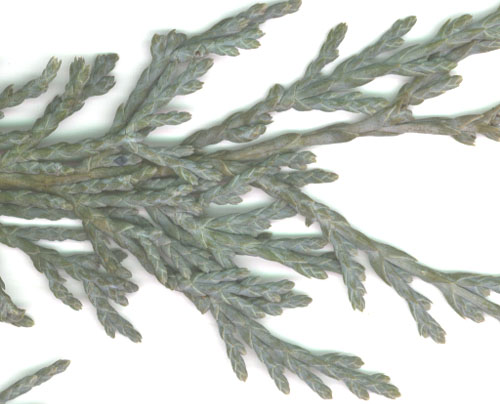Juniperus scopulorum
Rocky Mountain Juniper, Colorado Redcedar
Cupressaceae
ExpandHabitat
- native to eastern foothills of Rocky Mountains, North America
- zone 3
- found in dry soil on rocky ridges
Habit and Form
- evergreen tree
- narrow, conical shape, opening when mature
- 30' to 40' tall and 3' to 12' wide
- branches are somewhat vertical growing
- slow to moderate growth rate
- medium texture
Summer Foliage
- leaves are scale-like
- closely pressed to stem
- opposite leaf arrangement
- smooth margins
- color varies from a deep green to blue-green
Autumn Foliage
- evergreen, no fall color
Flowers
- plants can be monoecious or dioecious
- male flowers have only 6 stamens (J. virginiana has double this number)
- yellow in color
Fruit
- rounded, 2-seeded berry-like cones
- 0.25" to 0.33" in diameter
- deep blue color
- takes two years to reach maturity
Bark
- reddish brown coloring, sometimes gray
- shredding appearance
Culture
- easily transplanted
- tolerant of most conditions , except wet soils
- pH adaptable
- not tolerant of high humidity
- full sun
Landscape Use
- specimen
- screen
- mass plantings
- container
- hedges
- foundation plantings
Liabilities
- susceptible to juniper blights
- can serves as alternate host for cedar-apple rust
- cankers can be a problem
ID Features
- scale-like leaves
- narrow, conical growth habit
- most have a bluish cast to needles
- needles are opposite and closely pressed to stem
- branches and twigs are vertical
- blue fruits
Propagation
- by cuttings
Cultivars/Varieties
'Blue Trail' - This is a columnar, blue-foliaged form growing to 20' tall and 6' wide. It has a good tolerance for dry soil.
'Cologreen' - This cone-like form can reach 15' to 20' tall and about 6' wide. The bright green foliage is closely knit, making the plant appear quite dense and compact. It is hardy to zone 3.
'Gray Gleam' - This is a slow-growing columnar form with dense branching and silvery gray-blue foliage that intensifies in the winter. It is columnar and slow-growing to 15' tall and 5' to 7' wide.
'Medora' - A narrow columnar plant with a mature height of 10'-12' feet and a 3' width, this plant has blue-green foliage. It is hardy to USDA zone 3 and originated in the Badlands of South Dakota.
'Monam' (Blue Creeper™) - This plant has a low, spreading habit that forms a mound 2' tall and 6' to 8' wide. It has excellent blue foliage color that is intensified by cold weater.
'Moonglow' - A dense pyramidal selection to 20' tall, this plant has silver-blue foliage and requires little trimming.
'Pathfinder' - This selection is narrow pyramidal form with dense branches of blue-gray foliage. It matures at 20' tall with an 8' spread.
'Skyrocket' - This is perhaps the most popular upright landscape juniper, forming a narrow column of tight branches carrying silvery blue foliage. It grows rapidly to 15' tall and 2' wide, requiring little maintenance.
'Sutherland' - A broad pyramid to 20' tall, this plant has silvery green foliage.
'Tolleson's Blue Weeping' (also called 'Tolleson's Weeping Juniper') - A tree-like form to 20' tall, this unusual form has arching branches to 10' wide which display hanging string-like strips of silvery gray-blue foliage. This plant is best used as a specimen and seems to tolerate varied climates. A similar green form is called 'Tolleson's Green Weeping'.
'Welchii' - The height of this form is 8' to 15' with a narrow, compact columnar habit. The foliage is silver-green.
'Wichita Blue' - This selection displays excellent bright blue foliage that holds its color well all year. It has a pyramidal, upright habit to 10'-15' tall and about 5' wide.

